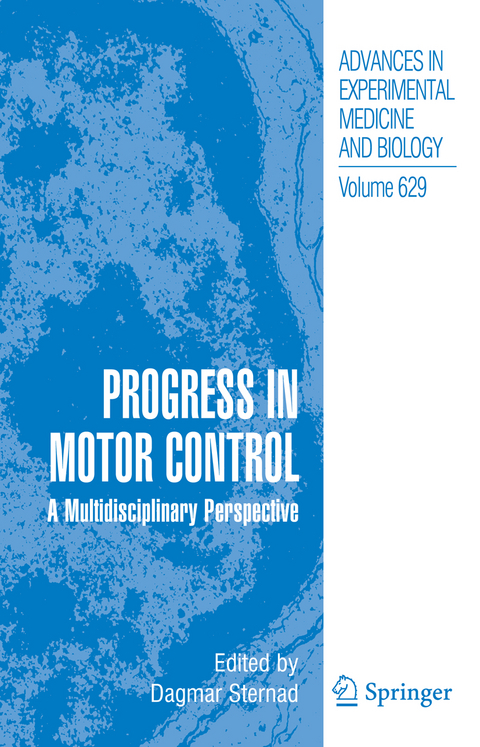
Progress in Motor Control
Springer-Verlag New York Inc.
978-1-4899-7900-1 (ISBN)
The Nature of Motor Control.- Nature of Motor Control: Not Strictly “Motor”, Not Quite “Control”.- Beyond Control: The Dynamics of Brain-Body-Environment Interaction in Motor Systems.- Towards Testable Neuromechanical Control Architectures for Running.- Control from an Allometric Perspective.- Synergies: Atoms of Brain and Behavior.- Nature of Motor Control: Perspectives and Issues.- What is Encoded in the Brain?.- Past, Present, and Emerging Principles in the Neural Encoding of Movement.- From Intention to Action: Motor Cortex and the Control of Reaching Movements.- Control of Muscle Synergies by Cortical Ensembles.- Behavioral and Neurophysiological Aspects of Target Interception.- Learning from Learning: What Can Visuomotor Adaptations Tell us About the Neuronal Representation of Movement?.- The Problem of Parametric Neural Coding in the Motor System.- Perception and Action.- to Section on Perception and Action.- Mutuality in the Perception of Affordances and the Control of Movement.- Object Avoidance During Locomotion.- The Roles of Vision and Proprioception in the Planning of Reaching Movements.- Using Predictive Motor Control Processes in a Cognitive Task: Behavioral and Neuroanatomical Perspectives.- The Human Mirror Neuron System and Embodied Representations.- Disorders of the Perceptual-Motor System.- Motor Learning.- Some Contemporary Issues in Motor Learning.- Motor Learning and Consolidation: The Case of Visuomotor Rotation.- Cortical Processing during Dynamic Motor Adaptation.- Motor Learning: Changes in the Structure of Variability in a Redundant Task.- Time Scales, Difficulty/Skill Duality, and the Dynamics of Motor Learning.- Bridging of Models for Complex Movements in 3D.- Bridging of Models for Complex Movements in 3D.- The Posture-Based MotionPlanning Framework: New Findings Related to Object Manipulation, Moving Around Obstacles, Moving in Three Spatial Dimensions, and Haptic Tracking.- Grasping Occam’s Razor.- Review of Models for the Generation of Multi-Joint Movements in 3-D.- The Hand as a Complex System.- Why the Hand?.- Selective Activation of Human Finger Muscles after Stroke or Amputation.- Neural Control of Hand Muscles During Prehension.- Multi-Finger Prehension: Control of a Redundant Mechanical System.- A Mathematical Approach to the Mechanical Capabilities of Limbs and Fingers.- Forty Years of Equilibrium-Point Hypothesis.- Origin and Advances of the Equilibrium-Point Hypothesis.- The Biomechanics of Force Production.- The Implications of Force Feedback for the ? Model.- Control and Calibration of Multi-Segment Reaching Movements.- The Equilibrium-Point Hypothesis – Past, Present and Future.
| Erscheinungsdatum | 15.07.2016 |
|---|---|
| Reihe/Serie | Advances in Experimental Medicine and Biology ; 629 |
| Zusatzinfo | XVIII, 734 p. |
| Verlagsort | New York |
| Sprache | englisch |
| Maße | 155 x 235 mm |
| Themenwelt | Geisteswissenschaften ► Psychologie ► Biopsychologie / Neurowissenschaften |
| Medizin / Pharmazie ► Medizinische Fachgebiete ► Neurologie | |
| Medizin / Pharmazie ► Physiotherapie / Ergotherapie ► Rehabilitation | |
| Medizin / Pharmazie ► Studium | |
| Naturwissenschaften ► Biologie ► Humanbiologie | |
| Naturwissenschaften ► Biologie ► Zoologie | |
| Naturwissenschaften ► Physik / Astronomie ► Thermodynamik | |
| ISBN-10 | 1-4899-7900-X / 148997900X |
| ISBN-13 | 978-1-4899-7900-1 / 9781489979001 |
| Zustand | Neuware |
| Haben Sie eine Frage zum Produkt? |
aus dem Bereich


